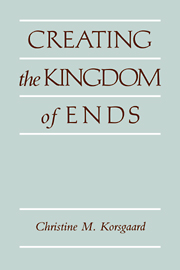Book contents
- Frontmatter
- Contents
- Introduction
- Abbreviations for Kant's works
- PART ONE KANT'S MORAL PHILOSOPHY
- 1 An introduction to the ethical, political, and religious thought of Kant
- 2 Kant's analysis of obligation: The argument of Groundwork I
- 3 Kant's Formula of Universal Law
- 4 Kant's Formula of Humanity
- 5 The right to lie: Kant on dealing with evil
- 6 Morality as freedom
- 7 Creating the Kingdom of Ends: Reciprocity and responsibility in personal relations
- PART TWO COMPARATIVE ESSAYS
- Bibliography
- Sources
- Other publications by the author
- Index
- Index of citations
3 - Kant's Formula of Universal Law
Published online by Cambridge University Press: 05 June 2012
- Frontmatter
- Contents
- Introduction
- Abbreviations for Kant's works
- PART ONE KANT'S MORAL PHILOSOPHY
- 1 An introduction to the ethical, political, and religious thought of Kant
- 2 Kant's analysis of obligation: The argument of Groundwork I
- 3 Kant's Formula of Universal Law
- 4 Kant's Formula of Humanity
- 5 The right to lie: Kant on dealing with evil
- 6 Morality as freedom
- 7 Creating the Kingdom of Ends: Reciprocity and responsibility in personal relations
- PART TWO COMPARATIVE ESSAYS
- Bibliography
- Sources
- Other publications by the author
- Index
- Index of citations
Summary
Kant's first formulation of the categorical imperative, the Formula of Universal Law, runs:
Act only according to that maxim by which you can at the same time will that it should become a universal law. (G 421)
A few lines later, Kant says that this is equivalent to acting as though your maxim were by your will to become a law of nature, and he uses this latter formulation in his examples of how the imperative is to be applied. Elsewhere, Kant specifies that the test is whether you could will the universalization for a system of nature “of which you yourself were a part” (C2 69); and in one place he characterizes the moral agent as asking “what sort of world he would create under the guidance of practical reason, … a world into which, moreover, he would place himself as a member” (R 5). But how do you determine whether or not you can will a given maxim as a law of nature? Since the will is practical reason, and since everyone must arrive at the same conclusions in matters of duty, it cannot be the case that what you are able to will is a matter of personal taste, or relative to your individual desires. Rather, the question of what you can will is a question of what you can will without contradiction.
- Type
- Chapter
- Information
- Creating the Kingdom of Ends , pp. 77 - 105Publisher: Cambridge University PressPrint publication year: 1996
- 13
- Cited by



